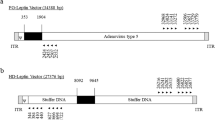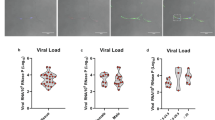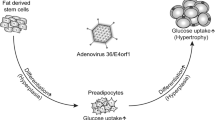Abstract
Human adenovirus Ad36 increases adiposity in several animal models, including rodents and non-human primates. Importantly, Ad36 is associated with human obesity, which has prompted research to understand its epidemiology and to develop a vaccine to prevent a subgroup of obesity. For this purpose, understanding the genomic stability of Ad36 in vivo and in vitro infections is critical. Here, we examined whether in vitro cell passaging over a 14-year period introduced any genetic variation in Ad36. We sequenced the whole genome of Ad36–which was plaque purified in 1998 from the original strain obtained from American Type Culture Collection, and passaged approximately 12 times over the past 14 years (Ad36-2012). This DNA sequence was compared with a previously published sequence of Ad36 likely obtained from the same source (Ad36-1988). Compared with Ad36-1988, only two nucleotides were altered in Ad36-2012: a T insertion at nucleotide 1862, which may induce early termination of the E1B viral protein, and a T→C transition at nucleotide 26 136. Virus with the T insertion (designated Ad36-2012-T6) was mixed with wild-type virus lacking the T insertion (designated Ad36-2012-T5) in the viral stock. The transition at nucleotide 26 136 does not change the encoded amino acid (aspartic acid) in the pVIII viral protein. The rate of genetic variation in Ad36 is ∼2.37 × 10–6 mutations/nucleotide/passage. Of particular importance, there were no mutations in the E4orf1 gene, the critical gene for producing obesity. This very-low-variation rate should reduce concerns about genetic variability when developing Ad36 vaccines or developing assays for detecting Ad36 infection in populations.
This is a preview of subscription content, access via your institution
Access options
Subscribe to this journal
Receive 12 print issues and online access
$259.00 per year
only $21.58 per issue
Buy this article
- Purchase on Springer Link
- Instant access to full article PDF
Prices may be subject to local taxes which are calculated during checkout

Similar content being viewed by others
References
Rowe WP, Huebner RJ, Gilmore LK, Parrott RH, Ward TG . Isolation of a cytopathogenic agent from human adenoids undergoing spontaneous degeneration in tissue culture. Proc Soc Exp Biol Med 1953; 84: 570–573.
Singh G, Robinson CM, Dehghan S, Schmidt T, Seto D, Jones MS et al. Overreliance on the hexon gene, leading to misclassification of human adenoviruses. J Virol 2012; 86: 4693–4695.
Dhurandhar NV . Is obesity caused by an adenovirus? Expert Rev Anti Infect Ther 2012; 10: 521–524.
Dhurandhar NV . A framework for identification of infections that contribute to human obesity. Lancet Infect Dis 2011; 11: 963–969.
Na HN, Nam JH . Infectobesity: a new area for mocrobiological and virological research. J Bacteriol Virol 2011; 41: 65–76.
Trovato GM, Martines GF, Garozzo A, Tonzuso A, Timpanaro R, Pirri C et al. Ad-36 adipogenic adenovirus in human non-alcoholic fatty liver disease. Liver Int 2010; 30: 184–190.
Dhurandhar NV . Insulin sparing action of Adenovirus 36 and its E4orf1 protein. J. Diabetes Complications 2012; 27: 191–199.
Smith JG, Wiethoff CM, Stewart PL, Nemerow GR . Adenovirus. Curr Top Microbiol Immunol 2010; 343: 195–224.
Regoes RR, Hamblin S, Tanaka MM . Viral mutation rates: modelling the roles of within-host viral dynamics and the trade-off between replication fidelity and speed. Proc Biol Sci 2012; 280: 20122047.
Dhurandhar NV, Israel BA, Kolesar JM, Mayhew GF, Cook ME, Atkinson RL . Increased adiposity in animals due to a human virus. Int J Obes Relat Metab Disord 2000; 24: 989–996.
Arnold J, Jánoska M, Kajon AE, Metzgar D, Hudson NR, Torres S et al. Genomic characterization of human adenovirus 36, a putative obesity agent. Virus Res 2010; 149: 152–161.
Dean FB, Nelson JR, Giesler TL, Lasken RS . Rapid amplification of plasmid and phage DNA using phi29 DNA polymerase and multiply-primed rolling circle amplification. Genome Res 2001; 11: 1095–1099.
Lauer KP, Llorente I, Blair E, Seto J, Krasnov V, Purkayastha A et al. Natural variation among human adenoviruses: genome sequence and annotation of human adenovirus serotype 1. J Gen Virol 2004; 85: 2615–2625.
Sáenz Robles MT, Pipas JM . T antigen transgenic mouse models. Semin Cancer Biol 2009; 19: 229–235.
Seto J, Walsh MP, Mahadevan P, Zhang Q, Seto D . Applying genomic and bioinformatic resources to human adenovirus genomes for use in vaccine development and for applications in vector development for gene delivery. Viruses 2010; 2: 1–26.
Cheng TP, Valentine MC, Gao J, Pingel JT, Yokoyama WM . Stability of murine cytomegalovirus genome after in vitro and in vivo passage. J Virol 2010; 84: 2623–2628.
Mahadevan P, Seto J, Tibbetts C, Seto D . Natural variants of human adenovirus type 3 provide evidence for relative genome stability across time and geographic space. Virology 2010; 397: 113–118.
Robinson CM, Seto D, Jones MS, Dyer DW, Chodosh J . Molecular evolution of human species D adenoviruses. Infect Genet Evol 2011; 11: 1208–1217.
Krishnapuram R, Dhurandhar EJ, Dubuisson O, Kirk-Ballard H, Bajpeyi S et al. Template to improve glycemic control without reducing adiposity or dietary fat. Am J Physiol Endocrinol Metab 2011; 300: E779–E789.
Na HN, Nam JH . Adenovirus 36 as an obesity agent maintains the obesity state by increasing MCP-1 and inducing inflammation. J Infect Diseas 2012; 205: 914–922.
Acknowledgements
Research funded in part by Vital Health Interventions, to NVD, and by a National Research Foundation of Korea Grant funded by the Korean Government (NRF-2012S1A2A1A01028997), the Catholic University of Korea, Research Fund 2013, and a grant from GRRC of the Catholic University of Korea to J-HN, and by the Beers-Murphy Clinical Nutrition Center at the University of Wisconsin, Madison, USA.
Author information
Authors and Affiliations
Corresponding authors
Ethics declarations
Competing interests
The following Patents are granted or have been applied by NVD for: Patent number 6 127 113: Viral obesity methods and compositions. Patent number 6 664 050: Viral obesity methods and compositions. Patent number US 8 008 436B2, dated 30 August 2011: Adenovirus 36 E4orf1 gene and protein and their uses. Provisional patent filed: Adenovirus Ad36 E4orf1 protein for prevention and treatment of non-alcoholic fatty liver disease, July 2010. Provisional patent filed: Enhanced glycemic control using Ad36E4orf1 and AKT1 Inhibitor. January 2012. RLA is the owner of Obetech, LLC, a company that provides assays for adenoviruses that produce obesity and owns multiple patents in the area of virus-induced obesity.
Additional information
Supplementary Information accompanies this paper on International Journal of Obesity website
Rights and permissions
About this article
Cite this article
Nam, JH., Na, HN., Atkinson, R. et al. Genomic stability of adipogenic human adenovirus 36. Int J Obes 38, 321–324 (2014). https://doi.org/10.1038/ijo.2013.67
Received:
Revised:
Accepted:
Published:
Issue Date:
DOI: https://doi.org/10.1038/ijo.2013.67
Keywords
This article is cited by
-
Adenovirus 36 prevalence and association with human obesity: a systematic review
International Journal of Obesity (2021)
-
Modulating effect of vitamin D status on serum anti-adenovirus 36 antibody amount in children with obesity: National Food and Nutrition Surveillance
BMC Pediatrics (2020)
-
Obesity and Diabetes in an Arab population: Role of Adenovirus 36 Infection
Scientific Reports (2020)
-
Viral Infections and Obesity
Current Obesity Reports (2017)
-
Adenovirus 36 DNA in human adipose tissue
International Journal of Obesity (2015)



